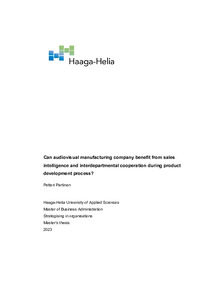Can audiovisual manufacturing company benefit from sales intelligence and interdepartmental cooperation during product development process?
Partinen, Petteri (2023)
Partinen, Petteri
2023
All rights reserved. This publication is copyrighted. You may download, display and print it for Your own personal use. Commercial use is prohibited.
Julkaisun pysyvä osoite on
https://urn.fi/URN:NBN:fi:amk-2023111629768
https://urn.fi/URN:NBN:fi:amk-2023111629768
Tiivistelmä
Systematic collection of sales intelligence and interdepartmental cooperation during the product development process is still rarely used in audiovisual manufacturing companies. Even though the concepts are not new, many companies have still failed to see the value they could deliver by implementing these in companies’ workflow. The goal of this research is to find out if adding cooperation between sales & R&D and sharing sales intelligence internally would benefit the new product development process. Research has been done in a way, which considers both viewpoints, sales, and R&D equally.
This research only concentrates on sales and R&D departments, how they see the value of sales intelligence, and whether there are any risks or possibilities in their cooperation. As a limitation, implementing and testing the given suggestions will not be part of this research. The marketing department and Market Intelligence (MI) have also been left out from this research because the sales-marketing connection offers value to the company at different points of the process compared to the connection between sales and R&D.
This research was conducted between March and November 2023 by using the qualitative case study method. The qualitative method was chosen as the recommended method when a research topic is a phenomenon. Data collection methods used in this research were interviews and online questionnaires, both with open-ended questions. Conducted interviews were done via telephone or Teams and the questionnaire link was sent to participants via e-mail. Using different data collection methods, data triangulation was possible.
A total of 14 people from 4 different companies participated in this research. Participants were chosen by using the purposive sampling method. For the research to be valid, participants needed to have either sales or R&D-related positions. Results were analysed by using thematic and abductive qualitative methods. Answers were coded, and based on the codes, themes were created.
The most significant finding of the research was that audiovisual manufacturing companies lacked a lot of processes and tools in their everyday activities and the communication between sales and R&D departments was limited. The benefits of cooperation were acknowledged, but the opinions about the parts of the process where cooperation would be most beneficial varied a lot. Based on these findings, suggested actions are presented at the end of the research. These actions are targeting improving the efficiency of the product development, by implementing an internal innovation group and creating a sales capability process alongside the new product development process.
This research only concentrates on sales and R&D departments, how they see the value of sales intelligence, and whether there are any risks or possibilities in their cooperation. As a limitation, implementing and testing the given suggestions will not be part of this research. The marketing department and Market Intelligence (MI) have also been left out from this research because the sales-marketing connection offers value to the company at different points of the process compared to the connection between sales and R&D.
This research was conducted between March and November 2023 by using the qualitative case study method. The qualitative method was chosen as the recommended method when a research topic is a phenomenon. Data collection methods used in this research were interviews and online questionnaires, both with open-ended questions. Conducted interviews were done via telephone or Teams and the questionnaire link was sent to participants via e-mail. Using different data collection methods, data triangulation was possible.
A total of 14 people from 4 different companies participated in this research. Participants were chosen by using the purposive sampling method. For the research to be valid, participants needed to have either sales or R&D-related positions. Results were analysed by using thematic and abductive qualitative methods. Answers were coded, and based on the codes, themes were created.
The most significant finding of the research was that audiovisual manufacturing companies lacked a lot of processes and tools in their everyday activities and the communication between sales and R&D departments was limited. The benefits of cooperation were acknowledged, but the opinions about the parts of the process where cooperation would be most beneficial varied a lot. Based on these findings, suggested actions are presented at the end of the research. These actions are targeting improving the efficiency of the product development, by implementing an internal innovation group and creating a sales capability process alongside the new product development process.
